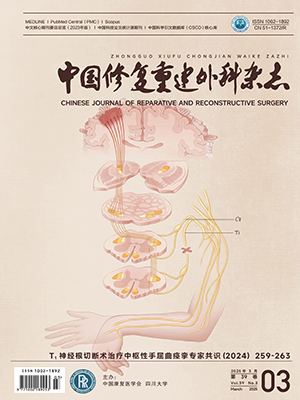Objective To assess the effectivness of different bone graft fusion ways in the treatment of thoracolumbar burst fractures. Methods Between June 2000 and June 2009, 126 cases of thoracolumbar burst fractures were treated by onestage
posterior short segment internal fixation combined with bone graft fusion. All patients had acute spine and spinal injury
at the levels of T11-L2, who were with different degrees of neural function injury (below Frankel grade D). The patients were randomly divided into 3 groups and were treated respectively by centrum combined with interbody bone graft fusion (group A), posterolateral bone graft fusion (group B), and ring bone graft fusion (group C) combined with posterior short segment pedicle instrumentation. The changes of the Cobb angle, correction loss of Cobb angle, bone fusion rate, internal fixation failure rate, Oswestry Disabil ity Index (ODI), and Frankel grade of the fracture vertebral were observed after operation to evaluate the effectiveness of different bone graft fusion ways. Results All 126 cases were followed up 24-32 months (mean, 28 months). The operation time and bleeding volume in group C were significantly larger than those in groups A and B (P lt; 0.05), but no significant difference was found between groups A and B (P gt; 0.05). At 2 years after operation and last follow-up, the Cobb angle and correction loss in group B were significantly larger than those in groups A and C (P lt; 0.05), but there was no significant difference between groups A and C (P gt; 0.05). At last follow-up, the bone fusion rate and internal fixation failure rate were 100% and 0 in group A, 78.6% and 21.4% in group B, and 97.5% and 0 in group C; there were significant differences between group B and groups A, C (P lt; 0.05), but no significant difference was found between groups A and C (P gt; 0.05). ODI and Frankel grade were obviously improved after operation, showing significant differences between preoperation and last follow-up (P lt; 0.05) in 3 groups, between group B and groups A, C (P lt; 0.05), but no significant difference was found between groups A and C (P gt; 0.05). Conclusion The centrum combined with interbody bone graft fusion is best in 3 bone graft fusion ways because of its optimum bone fusion and according with human body biomechanics mechanism. Back outboard bone graft fusion may not a appropriate bone fusion way because of its high internal fixation failure rate and not according with human body biomechanics mechanism. The ring bone graft fusion may not be an indispensable bone fusion way because of its common bone fusion ratio and lower cost-performance ratio.
Citation: LUO Yi,DENG Zhansheng,CHEN Jing.. EFFECTIVENESS OF DIFFERENT BONE GRAFT FUSION WAYS IN TREATING THORACOLUMBAR BURST FRACTURES. Chinese Journal of Reparative and Reconstructive Surgery, 2011, 25(11): 1302-1307. doi: Copy
Copyright © the editorial department of Chinese Journal of Reparative and Reconstructive Surgery of West China Medical Publisher. All rights reserved




